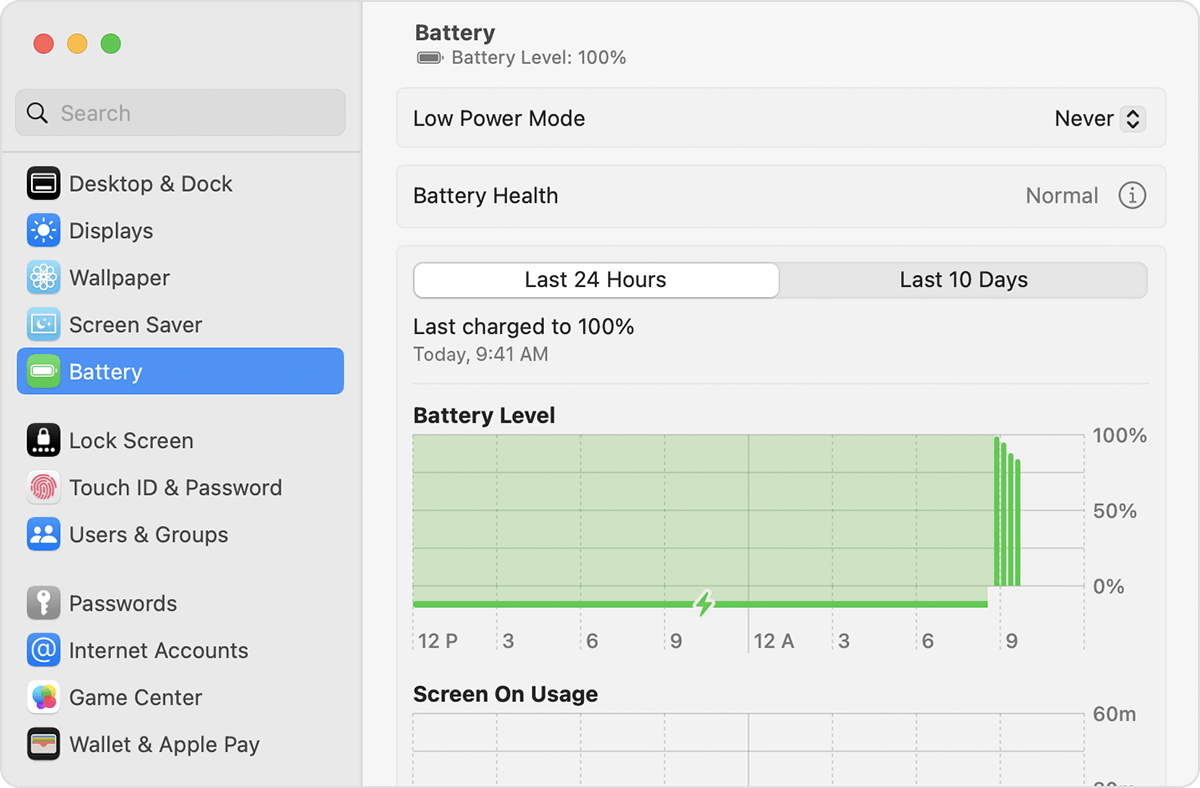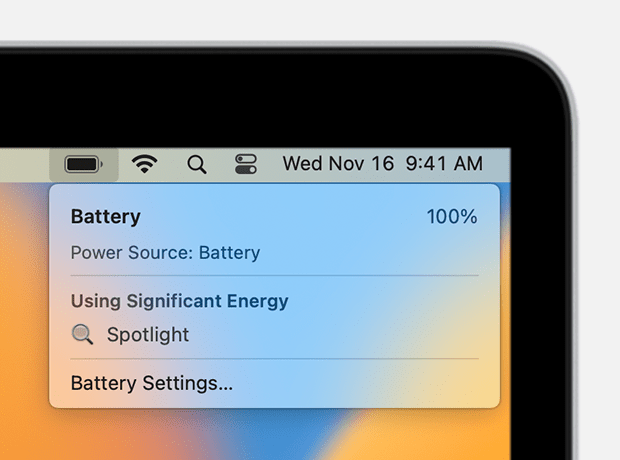Get help with your Mac laptop battery
Get help with your Mac laptop battery
How to optimize battery life, diagnose battery issues, and get battery service.
Use settings that optimize battery life
Laptop battery life is affected by how your Mac is configured and how you're using it, but you can improve battery life by using settings that help conserve energy.
Check Battery settings
From the Apple menu in the menu bar, choose System Settings (or System Preferences), then click Battery. To see additional settings when using macOS Ventura or later, click Options.
Battery settings related to power modes or energy modes affect energy use, as do settings that enable your Mac to wake for network access or optimize video streaming while on battery. Availability of these and other settings varies by Mac.
Check Displays settings
Choose Apple menu > System Settings (or System Preferences), then click Displays. To see additional settings, click Advanced.
Displays settings related to brightness affect energy use, including settings that enable your Mac to automatically adjust brightness, compensate for ambient light, or slightly dim the display while on battery. Availability of these and other settings varies by Mac.
Diagnose battery issues
To help diagnose battery issues, check the health and charging status of your battery.
Check Battery Health
Choose Apple menu > System Preferences (or System Settings), then click Battery. The Battery information shown here includes Battery Health:
- Normal: The battery is functioning normally.
- Service Recommended: The battery's ability to hold charge is less than when it was new, or the battery isn't functioning normally. You can safely continue to use your Mac, but if your battery needs service or its lowered charging capacity is affecting your experience, get your battery evaluated at an Apple Store or Apple Authorized Service Provider, or contact Apple.

In some earlier versions of macOS, battery health might be reported as Replace Soon, Replace Now, or Service Battery, and might appear in the battery status menu instead of Battery settings: Press and hold the Option (or Alt) key while clicking the battery status menu ![]() in the menu bar.
in the menu bar.
Some third-party apps also report battery health conditions, but the data they report might not be accurate or conclusively indicate diminished system runtime. It's best to rely on the battery-health information reported by macOS.
Resolve battery-charging issues
The battery status menu ![]() in the menu bar shows how much charge your battery has, whether it's currently charging, and whether your display or any apps are using significant energy. When your Mac is connected to power and using optimized battery charging in macOS Big Sur or later, this menu also shows information such as whether charging is paused and when your battery will be fully charged.
in the menu bar shows how much charge your battery has, whether it's currently charging, and whether your display or any apps are using significant energy. When your Mac is connected to power and using optimized battery charging in macOS Big Sur or later, this menu also shows information such as whether charging is paused and when your battery will be fully charged.

Occasionally your battery might not show a full charge (100%), even after the power adapter has been connected for a long time. This is optimized battery charging, which helps prolong the overall life of the battery. If charging is on hold and you need your battery to be fully charged sooner, choose Charge To Full Now from the battery status menu ![]() .
.
If your battery isn't charging, make sure that you're using the correct power adapter for your Mac. If the power adapter isn't rated for at least the wattage that your Mac requires, it might not charge your Mac reliably. If you're using the correct power adapter, make sure that the power adapter isn't at fault:
If your battery still doesn't charge:
- Shut down your Mac, close its lid for 30 seconds, then try to charge again.
- If you're using an Intel-based Mac, it might help to reset the SMC.
Use Apple Diagnostics
The tests performed by Apple Diagnostics include tests for battery issues.
Get service for your battery
Your Apple One Year Limited Warranty includes replacement coverage for a defective battery. If you purchased an AppleCare Protection Plan for your Mac laptop and your battery retains less than 80 percent of its original capacity, Apple will replace the battery at no charge. If you don't have coverage, you can have the battery replaced for a fee.
MacBook, MacBook Air, and MacBook Pro computers with built-in batteries should have their batteries replaced only by an Apple Authorized Service Provider or Apple Store, or by an Independent Repair Provider that uses genuine Apple parts.1 Repairs performed by untrained individuals or using non-genuine Apple parts could damage your equipment, and such damage is not covered by warranty. Genuine Apple parts are also available for out-of-warranty repairs through Self Service Repair.2
Some older Mac laptops have removable batteries that you can replace yourself. Contact an Apple Authorized Service Provider or Apple Store for help servicing a removable battery.
Related Articles
Charge the MacBook Pro battery
Charge the MacBook Pro battery The battery in your MacBook Pro recharges whenever the MacBook Pro is connected to power. Charge the battery. Connect your MacBook Pro to a power outlet using the included cable and power adapter. To learn more about ...If your Mac doesn't turn on
Check power connections Make sure that your power cable is undamaged and plugged securely into your Mac and a working electrical outlet. If your Mac has no built-in display, make sure that your external display is connected to power, connected to ...Identify your Mac power adapter
Identify your Mac power adapter Learn which power adapter and cable comes with your Mac laptop and how to check the wattage of a connected power adapter or display. If your Mac uses USB-C to charge, you can charge your Mac laptop with any USB-C power ...Update macOS on Mac
Update macOS on Mac Use Software Update to install updates and upgrades for macOS and its built-in apps, including Safari. Use Software Update Before installing new software, it's a good idea to back up your Mac. To check for new software, open ...Back up your Mac with Time Machine
Back up your Mac with Time Machine Learn how to create a backup of the files on your Mac. Use Time Machine, the built-in backup feature of your Mac, to automatically back up your personal data, including apps, music, photos, email, and documents. ...